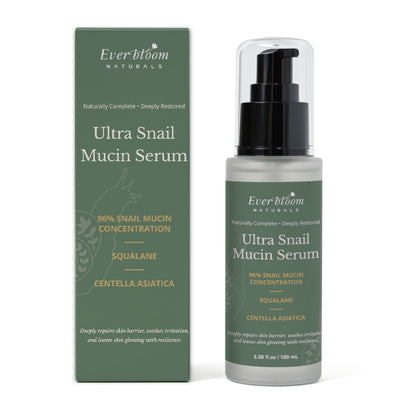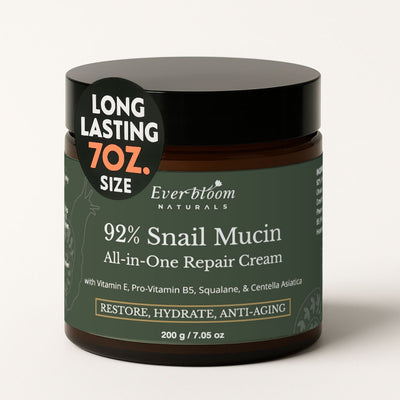In the ever-evolving world of skincare, new ingredients constantly emerge, promising miraculous results. Yet, some stand the test of time, proving their worth through consistent efficacy. Among these enduring stars are snail mucin vs hyaluronic acid – two immensely popular ingredients celebrated for their powerful hydrating and skin-repairing benefits. For beginners navigating the vast array of skincare options, understanding the nuances between these two powerhouses can be a game-changer.
While both snail mucin and hyaluronic acid are lauded for their ability to deliver moisture and improve skin health, they are fundamentally different in their composition, origin, and the specific ways they interact with your skin. This article will delve into each ingredient individually, break down their unique properties, and directly compare their functions and results. Our goal is to help you decipher which ingredient, or perhaps both, is best suited for your specific skin type and concerns, from moisture retention and skin barrier support to soothing irritation and promoting a healthy, radiant glow.
Understanding Snail Mucin: The Elixir from Nature
What is Snail Mucin?
Snail mucin, also known as snail secretion filtrate (SSF), is a complex substance produced by snails. While the thought of applying snail slime to your face might seem unconventional to some, its use in skincare dates back to ancient Greece, where Hippocrates reportedly recommended crushed snails for soothing inflamed skin [10]. Modern interest in snail mucin for dermatological applications surged after Chilean snail farmers noticed their hands healed faster and were softer when handling snails for culinary purposes.
At its core, snail mucin is a sophisticated cocktail of beneficial compounds. It contains a rich blend of glycoproteins, proteoglycans, enzymes, peptides, hyaluronic acid-like substances (though not hyaluronic acid itself, which we will clarify later), glycolic acid, allantoin, and antioxidants [10]. This intricate composition is what gives snail mucin its diverse range of skin-loving properties.
Benefits of Snail Mucin for Skin
The unique blend of components in snail mucin translates into a wide array of benefits for the skin:
- Intense Hydration and Moisture Retention: Snail mucin helps the skin attract and lock in moisture, contributing to a plump, dewy complexion [1], [9]. Its ability to form a protective barrier on the skin's surface also helps reduce transepidermal water loss (TEWL), keeping skin hydrated for longer.
- Skin Repair and Regeneration: One of snail mucin's most acclaimed benefits is its capacity to promote skin repair and regeneration. It can aid in wound healing, reduce the appearance of acne scars, and support the skin's natural healing processes [2], [9], [10]. This regenerative effect also contributes to its anti-aging properties, as it can help stimulate collagen production, leading to smoother skin and reduced fine lines [9].
- Soothing and Anti-Inflammatory Properties: For irritated or sensitive skin, snail mucin offers significant soothing benefits. It can help calm redness and inflammation, making it a favorite for those with compromised skin barriers or post-acne irritation [2].
- Addressing Hyperpigmentation: Some studies suggest that snail mucin can help fade hyperpigmentation and improve overall skin tone, contributing to a more even and radiant complexion [9].
Does Snail Mucin Have Hyaluronic Acid?
This is a common question, and it's important to clarify. While snail mucin is an excellent hydrator and contains components that function similarly to hyaluronic acid in terms of moisture retention, it does not contain hyaluronic acid itself in its chemical structure. Snail mucin is a complex biological secretion with its own unique set of polysaccharides and glycoproteins that contribute to its hydrating properties [10]. So, when you ask, does snail mucin have hyaluronic acid, the answer is no, not directly. However, it does contain substances that help your skin retain moisture and support its natural hydration mechanisms, much like hyaluronic acid does, but through different biological pathways.
Understanding Hyaluronic Acid: The Hydration Magnet
What is Hyaluronic Acid?
Hyaluronic acid (HA) is a naturally occurring polysaccharide found throughout the human body, with the highest concentrations in the skin, connective tissues, and eyes. Its primary function is to retain water, making it a critical component for maintaining skin hydration, elasticity, and plumpness. HA has an extraordinary capacity to hold water—up to 1,000 times its weight—making it an unparalleled humectant in skincare [4].
In skincare products, hyaluronic acid can come in various molecular weights. Larger HA molecules typically sit on the skin's surface, providing immediate hydration and forming a protective barrier to prevent moisture loss. Smaller, fragmented HA molecules can penetrate deeper into the skin, delivering hydration to multiple layers and supporting the skin's internal moisture reservoirs [3], [4].
Benefits of Hyaluronic Acid for Skin
The widespread acclaim for hyaluronic acid in skincare is due to its impressive benefits:
- Intense Hydration and Plumpness: HA is a master hydrator. By drawing moisture from the environment and binding it to the skin, it significantly improves skin hydration, leading to a visibly plumper, smoother complexion and reducing the appearance of fine lines caused by dehydration [4], [7].
- Skin Barrier Support: A well-hydrated skin barrier is a strong skin barrier. Hyaluronic acid helps reinforce the skin's natural protective barrier, making it more resilient against environmental aggressors and reducing sensitivity [3], [4].
- Anti-Aging Effects: By maintaining optimal hydration levels, HA helps the skin look more youthful. The plumping effect minimizes the look of fine lines and wrinkles, and some forms of HA can even stimulate the skin's own production of hyaluronic acid, contributing to long-term anti-aging benefits [4], [5], [8].
- Soothing and Wound Healing: HA has anti-inflammatory properties and plays a role in wound healing, making it beneficial for soothing irritated skin and supporting recovery processes [3], [8].
Is Snail Mucin the Same as Hyaluronic Acid?
To reiterate clearly: is snail mucin the same as hyaluronic acid? No, they are fundamentally different substances. Snail mucin is a complex biological secretion from snails, containing a wide array of compounds that contribute to skin repair, regeneration, and hydration. Hyaluronic acid, on the other hand, is a specific type of sugar molecule (a glycosaminoglycan) that is naturally present in human skin and is primarily known for its exceptional ability to attract and hold water. While both aim to improve skin health and hydration, they achieve these goals through distinct chemical structures and biological pathways. Think of them as two different tools in your skincare toolbox, both designed to build healthier skin, but each with its unique strengths.
Snail Mucin vs. Hyaluronic Acid: A Direct Comparison
Now that we've explored each ingredient individually, let's put them side-by-side to highlight their differences, helping you understand the hyaluronic acid vs snail mucin debate.
Compositional Differences
- Snail Mucin: A complex, natural bio-secretion comprising a mixture of proteins, peptides, enzymes, glycoproteins, and other compounds. Its richness lies in its diversity of active ingredients working synergistically [10].
- Hyaluronic Acid: A specific type of polysaccharide (a long chain of sugar molecules). While it's naturally occurring in the body, the HA used in skincare is often bio-engineered to control its molecular weight for optimal efficacy [4].
Functional Nuances
- Snail Mucin: Offers a broader range of benefits beyond just hydration. Its strengths lie in promoting skin regeneration, aiding in wound healing, soothing irritation, and improving skin texture by addressing concerns like acne scars and hyperpigmentation [9], [10]. It supports the skin's natural repair processes.
- Hyaluronic Acid: Primarily functions as an exceptional humectant. Its main role is to provide intense hydration, plump the skin, and support the skin barrier. While it does contribute to anti-aging by plumping, its core strength is moisture retention [3], [4].
Suitability for Skin Types and Concerns
- Snail Mucin: Ideal for individuals dealing with irritated, damaged, or compromised skin. It's particularly beneficial for those looking to address acne scars, redness, hyperpigmentation, or general signs of aging where skin regeneration and soothing are key. It can be a good choice for sensitive skin due to its calming properties.
- Hyaluronic Acid: A universal hydrator suitable for virtually all skin types. It is especially vital for dry, dehydrated, or sensitive skin that needs a boost in moisture. Its plumping effect makes it excellent for anyone looking to reduce the appearance of fine lines and achieve a smoother, more supple complexion.
Can You Use Snail Mucin and Hyaluronic Acid Together?
Absolutely! One of the most exciting aspects of modern skincare is the ability to combine ingredients for enhanced results. The question, can you use snail mucin and hyaluronic acid together, has a resounding 'yes' as an answer. In fact, they are often considered a powerhouse duo.
Synergistic Benefits
While distinct, snail mucin and hyaluronic acid offer complementary benefits that can synergistically improve your skin. Hyaluronic acid provides immediate, multi-depth hydration, acting like a sponge to plump up the skin's surface and deeper layers. Snail mucin then steps in with its reparative, soothing, and regenerative properties, working to heal, calm, and improve skin texture over time. Using them together creates a comprehensive approach to skin health, addressing both immediate hydration needs and long-term repair and resilience.
How to Layer Them
When layering skincare products, a general rule of thumb is to apply products from thinnest to thickest consistency. Typically, hyaluronic acid serums are lighter and more watery than snail mucin essences or creams. Therefore, the recommended order would be:
- Cleanse your face.
- Apply a toner (optional).
- Apply your hyaluronic acid serum. Allow it to absorb fully for a minute or two.
- Follow with your snail mucin essence or serum.
- Finish with your moisturizer and SPF (in the morning).
Benefits of Combination
Incorporating both into your routine can lead to:
- Enhanced and prolonged hydration.
- Improved skin barrier function and resilience.
- Accelerated healing of minor imperfections.
- Reduced redness and irritation.
- A more plump, smooth, and radiant complexion.
Choosing the Right Ingredient for Your Skin
The choice between snail mucin and hyaluronic acid, or whether to use both, ultimately depends on your individual skin concerns and goals.
When to Choose Snail Mucin
Opt for snail mucin if your skin:
- Is prone to irritation or redness.
- Needs help with repair, such as fading acne scars or post-inflammatory hyperpigmentation.
- Shows early signs of aging and could benefit from regeneration and collagen support.
- Feels compromised and needs soothing.
When to Choose Hyaluronic Acid
Reach for hyaluronic acid if your primary concerns are:
- Dehydration and dryness, regardless of your skin type.
- Lack of plumpness and elasticity.
- A desire to strengthen your skin's natural moisture barrier.
- You're looking for a universal hydrator that pairs well with most other ingredients.
Best of Both Worlds
For those who want comprehensive benefits—intense hydration, barrier support, regeneration, and soothing—integrating both snail mucin and hyaluronic acid into your routine can provide a holistic approach to achieving healthy, glowing skin.
Product Spotlight: Ultra Snail Mucin Repair Serum
For those ready to experience the transformative benefits of snail mucin, consider the Ultra Snail Mucin Repair Serum. This potent, Korean-inspired serum is specifically designed for powerful hydration and visible repair. With an impressive 96% snail mucin concentration, it directly aligns with the regenerative and soothing properties we've discussed for snail mucin, making it an excellent choice for targeting fine lines, fading imperfections, and restoring the skin's natural barrier.
Beyond its high purity snail mucin, this serum is infused with Centella Asiatica (CICA) to calm inflammation and Squalane to lock in moisture and boost elasticity. Its lightweight, fast-absorbing formula means it integrates seamlessly into any routine, leaving no sticky residue. It's gentle and safe for all skin types, including sensitive and aging skin, and is fragrance-free, paraben-free, and sulfate-free. The Triple-Action Benefits deliver deep hydration, anti-aging effects, and brightening for a more even, radiant skin tone, embodying the multifaceted advantages of snail mucin for a healthier-looking complexion. To learn more or to purchase, visit: Ultra Snail Mucin Repair Serum.
Conclusion
In the skincare arena, both snail mucin and hyaluronic acid stand out as exceptional ingredients, each bringing unique strengths to the table. Snail mucin excels in skin repair, regeneration, and soothing, making it a hero for compromised or aging skin. Hyaluronic acid, the ultimate hydration magnet, is unparalleled at plumping and moisturizing, benefiting virtually all skin types. Understanding their distinct compositions and functions empowers you to make informed decisions about your skincare routine.
Whether you choose one over the other, or decide to harness the combined power of both, remember that consistent and mindful application is key to unlocking their full potential. Embrace these skincare stars and enjoy the journey to a healthier, more radiant complexion.









